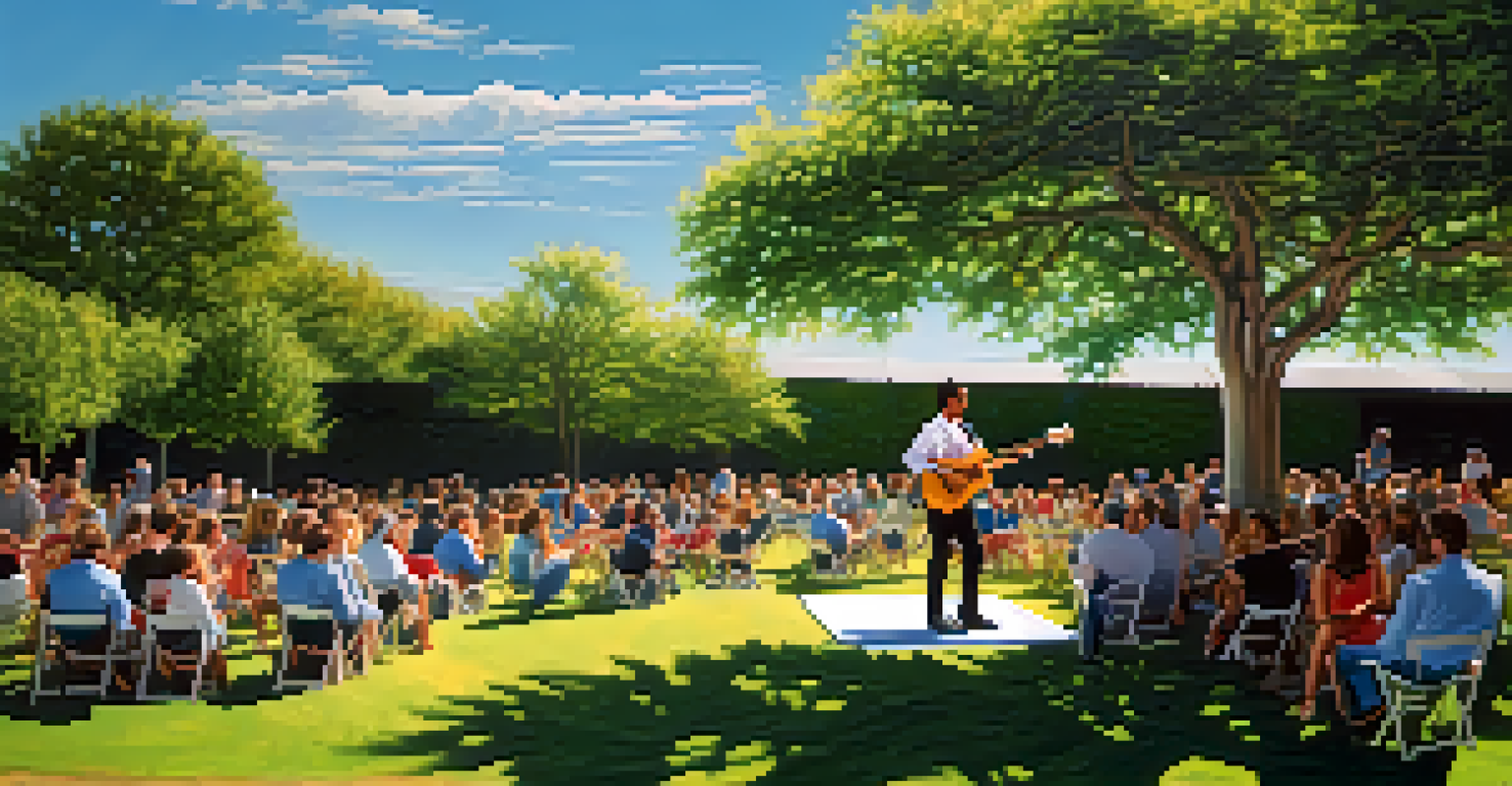Outdoor vs Indoor: Guitar Sound Characteristics Explained

Understanding the Basics of Guitar Sound
To appreciate the differences between outdoor and indoor guitar sounds, it's essential to grasp how sound works. Sound is essentially vibrations traveling through the air, and how those vibrations interact with their environment can significantly alter what you hear. The materials around your guitar – like walls, floors, and even the weather – play a crucial role in shaping its sound.
Music is the shorthand of emotion.
In an indoor setting, the sound waves bounce off walls, creating a warm and rich tone. This is often why musicians prefer practicing in their homes or studios, where they can control the acoustics. On the other hand, outdoor spaces tend to diffuse sound more, leading to a brighter but sometimes thinner sound profile.
Understanding these fundamentals sets the stage for exploring how different environments impact the way we experience guitar music. Whether you're strumming in a cozy room or jamming under the stars, each setting brings its own unique flavor to your sound.
The Impact of Acoustics on Sound Quality
Acoustics is the science of sound, and it varies vastly between indoor and outdoor environments. Indoor spaces often have controlled acoustics, where sound waves can reflect off surfaces in a way that enhances the music. This can create a fuller sound that feels enveloping and rich, making it ideal for recording sessions or intimate performances.

Conversely, outdoor environments are less predictable. The open space allows sound to disperse quickly, which can lead to a clearer sound but may lack the depth you’d find indoors. Factors like wind, temperature, and even the type of ground can influence how your guitar sounds outside, making it a challenge for live performances.
Indoor vs. Outdoor Sound Dynamics
The environment significantly influences guitar sound, with indoor spaces offering richer tones and outdoor settings providing clearer but sometimes thinner sound profiles.
Understanding these acoustic differences helps musicians make informed decisions about where to play. Whether you're indoors or outdoors, being aware of your surroundings can guide how you approach your music and the sound you wish to achieve.
Influence of Space Size on Guitar Sound
The size of the space where you play your guitar can drastically affect the sound. In a small room, sound waves have less distance to travel, creating a more immediate and intimate experience. This is perfect for solo practice or small gatherings, where the nuances of your playing can shine through.
The guitar is a miniature orchestra in itself.
In contrast, larger spaces, like open fields or concert venues, require more power to fill the area with sound. Here, your guitar might sound different, as the sound waves spread out and may lose some of their warmth. Musicians often need to adjust their playing style or equipment to ensure they still connect with their audience.
Recognizing how space size impacts sound can help you prepare for different performance settings. Whether you're cozying up in a small room or rocking out on a big stage, understanding these dynamics can enhance your overall performance.
Weather Effects on Outdoor Guitar Sound
Weather can be a significant player in how your guitar sounds outdoors. Humidity, temperature, and wind can all influence the quality of sound you produce. For instance, high humidity can make the air denser, which might enhance bass frequencies, giving your guitar a richer tone.
However, windy conditions can complicate things. Wind can carry sound waves away from your audience, making it difficult for them to appreciate the subtleties of your playing. This unpredictability means musicians often need to adapt their techniques or even choose specific locations that mitigate these challenges.
Acoustic Science Matters
Understanding acoustics is crucial for musicians, as controlled indoor environments enhance sound quality, while unpredictable outdoor conditions can challenge sound clarity.
Being mindful of weather conditions is crucial for outdoor performances. By considering the environment, you can better prepare to deliver an outstanding musical experience, regardless of Mother Nature’s mood.
Electric vs. Acoustic: Sound Considerations
When comparing outdoor and indoor sound characteristics, the type of guitar you’re using—electric or acoustic—also matters. Acoustic guitars rely on their body to project sound, which can be affected by the surrounding environment. Indoors, the walls can amplify the sound, while outdoors, the open space may lead to a more subdued experience.
Electric guitars, on the other hand, can be influenced by external factors like feedback and amplification. Outdoors, the lack of surfaces for sound waves to bounce off can sometimes create a more pronounced and sharper sound, which can be desirable for certain styles of music.
Understanding the nuances between electric and acoustic guitars helps musicians choose the right instrument for their environment. Being aware of how your guitar type interacts with its surroundings can enhance your sound, whether you're in a studio or under the open sky.
Personal Preferences in Sound Experience
Personal taste plays a significant role in how musicians perceive sound differences between indoor and outdoor settings. Some may prefer the vibrant and resonant tones of an indoor performance, where every note feels enriched by the space. Others might thrive in the open air, relishing the natural reverb that occurs when playing outside.
This preference often shapes performance decisions, from venue choice to sound settings. For instance, a guitarist who favors a fuller sound might gravitate towards indoor gigs, while someone who enjoys the rawness of an outdoor atmosphere might find joy in open-air festivals.
Personal Preferences Shape Experience
Musicians’ personal tastes greatly affect their performance choices, with some preferring the resonance of indoor settings and others enjoying the rawness of outdoor playing.
Ultimately, what matters most is how the music resonates with you and your audience. Embracing your preferences can lead to more fulfilling performances and a deeper connection with your art.
Tips for Optimizing Guitar Sound in Any Setting
Regardless of where you play, there are always ways to optimize your guitar sound. For indoor settings, consider adjusting the room’s furnishings to enhance acoustics—soft materials can absorb sound and reduce harsh reflections. Experimenting with positioning can also help; placing your guitar near walls can amplify its sound.
For outdoor performances, choosing the right spot is crucial. Look for areas with natural barriers, like trees or hills, which can help contain sound and enhance projection. Additionally, using amplifiers with built-in effects can help shape your tone to suit the open environment.

By implementing these tips, you can ensure that your guitar sounds its best, no matter the setting. A little preparation can go a long way in creating an unforgettable musical experience for both you and your audience.